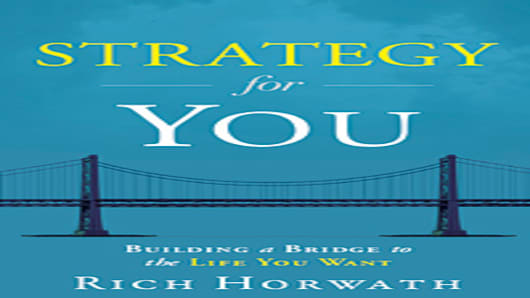GUEST AUTHOR BLOG: How to Live Strategically by Rich Horwath author of "Strategy for You: Building a Bridge to the Life You Want."
Do you have a plan for 2012?
If you're like 85% of adults, the answer is "Uhhh...no."
New research shows that only 15% of adults have a written plan for their lives outlining their goals and the strategies for accomplishing them. The majority of people will bounce around like bumper cars this year from one meaningless thing to the next.
January is a great time to get off the bumper car.
New Year's resolutions--those wonderful, wishful, seldom achieved aspirations--are one way to jumpstart your efforts at a more productive year. But, resolutions are only one piece of the big picture for creating your plan for 2012.
To achieve your goals in 2012, you need to think like a CEO – with a strategy.
Follow these five steps to create a strategy for you:
Step 1: Discover--Uncover Your Purpose through Insight. Resolutions to "lose weight, watch less TV, and eat fewer Twinkies," are generally not achieved because people fail to create the strategies that lead to them. The key is to not just establish the goal (what you are trying to achieve), but also the strategy that will help you get there. The same business-planning framework you're using at work (goals, objectives, strategies and tactics) can be applied to your life. Example:
- Goal (resolution): Lose weight
- Objective: Lose 15 pounds in six months
- Strategy: Eliminate weight-causing behaviors and create weight-reducing behaviors.
- Tactics: Drink diet soda rather than regular soda. Purchase a treadmill and elastic strength bands to exercise at home for thirty minutes a day, five days a week. Go to bed forty minutes earlier and wake up forty minutes earlier to complete exercise in the morning.
Step 2: Differentiate--Identify Your Unique Strengths. Each day, too many of us strive for a life of mediocrity and unfulfilled potential--at least, that's what our behavior indicates. We do the same things in the same ways as everyone else, and then we wonder why we haven't found success and happiness. We conform to standards at work, at school, in the neighborhood, and within society as a whole. Instead of seeking out ways to positively differentiate ourselves, we see our social activities, entertainment preferences, and PowerPoint presentations at work looking more and more similar to those of the people around us. If familiarity breeds contempt, similarity breeds apathy. After all, excellence, by its very definition, is deviation from the norm. Begin to identify your unique strengths by answering these three questions:
- What activities give me the greatest enjoyment?
- What do I do that people find value in? How do I do this differently than others?
- How can I intersect what I enjoy and what people find value in a way that is unique to me?
Step 3: Decide--Allocate Your Resources. Time, talent, and money. We all have these resources to varying degrees. The key is how effectively we use them in pursuit of our resolutions or goals. One way to more effectively use resources in support of achieving our resolutions is to take inventory of where we are currently investing them. For one week, carry a small notebook with you and record where you're spending your time (i.e., 45 hours at work, 16 hours watching TV, 7 hours commuting to work, etc.). This can be an eye-opening exercise because it gives us a better indication of the strategic trade-offs we need to make--the things we have chosen not to do. Decide how much time each week you'll need to invest in hitting your goal and any other resources you'll need to incorporate into your strategies.
Step 4: Design--Develop Your Action Plan. If you don't have your resolutions and the strategies for achieving them written down, they really don't exist. "Out of sight, out of mind," means out of luck when it comes to actually realizing your resolutions. Just as architects design blueprints to show what their structure will look like and the specific materials to create, a StrategyPrint® is an individual blueprint. It serves as a real-time strategic action plan, guiding you day in and day out, helping you stay focused on the strategies that will achieve your goals or resolutions. The StrategyPrint can include your purpose, situation analysis, goals, objectives, strategies, tactics and any other elements critical to your success.
Step 5: Drive--Execute Your Plan. The word drive can be defined as “to cause to move by force or compulsion; to carry and guide the movement of; to keep going.” There is nothing passive about it. Setting resolutions and strategies requires that you move from the passenger seat to the driver’s seat. Three elements essential to driving to the successful realization of your resolutions are preparation, communication and perseverance. Prepare to achieve your resolutions by thinking through the steps to develop appropriate strategies. Communicate your resolutions with those around you that can help and support your efforts. And realize that persevering through challenges is a part of the journey to get there.
Rich Horwath is CEO of the Strategic Thinking Institute, a former Chief Strategy Officer and professor of management. He previously authored the book Deep Dive: The Proven Method for Building Strategy. Horwath's new book is "Strategy for You: Building a Bridge to the Life You Want" (Greenleaf Book Group, January 2012). You can visit his website at www.strategyskills.com
Email me at bullishonbooks@cnbc.com — And follow me on Twitter @BullishonBooks


